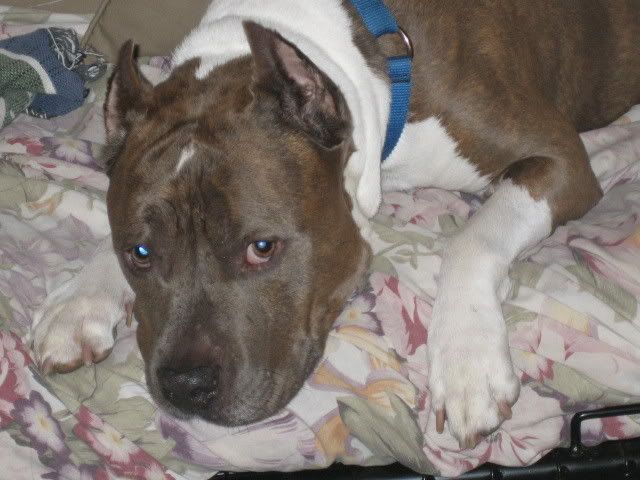Post by RealPitBull on Apr 7, 2014 13:37:52 GMT -5
by Barry Eaton.
What a great little book! Everyone who gets a puppy or new dog should go home with a copy of this. The forward, by Ian Dunbar:
The dominance myth ‘logic’ flow chart is flimsy at the best, but scary
at the worst. The notion is that:
1. Wolf social structure is entirely explained by a linear dominance
hierarchy in which there is a constant battle to be alpha
dog and dominate the rest of the pack.
2. Domestic dogs are descended from wolves and so the same
must apply to them.
3. Domestic dogs are trying to dominate us.
4. We should issue a pre-emptive strike and dominate dogs by
enforcing strict rules harshly.
In actual fact:
1. Wolf social structure is a wee bit more involved and sophisticated
than a single linear hierarchy—this is merely a Mickey
Mouse interpretation. Wolves have special friendships and allegiances
and by and large, wolves live together harmoniously.
2. Dogs are very (VERY) different from wolves. Domestic dogs
were selectively bred for thousands of years to be less fearful
and more easily socialized to people. If wolves and dogs were
the same, many people would be sharing their homes with
wolves.
3. Oh! Get a life!
4. This has to be the flimsiest, most thinly-veiled excuse for littlebrained,
schadenfreude types to label poor dogs as our adversaries
in the training arena and in the home.
Why on earth do we treat our best friend like our worse enemy?
How on earth can anybody think that a dog is trying to dominate
his owners by eating first, going through doorways first, enjoying the
comfort of furniture, playing games of tug-of-war, eagerly pulling
on leash, or relieving himself in the house? Dogs are not politicians.
Dogs are not masters of subtlety or innuendo. Dogs are straightforward
and they live in the here and now. If a dog wanted to dominate
his owner, he would do just that. End of story. Even so, when dogs
bark, growl, snap, lunge, nip or bite, rather than being aggressive
or dominant, the dog is usually, understandably, simply fearful of
domineering owners.
The ‘thinking’ behind the dominance myth and the Spartan, boot
camp, rank-reduction program is silly to the point of hilarious. Sadly,
downright silly thinking becomes extremely serious when dogs are
neglected and mistreated as a result. Indeed, many unsuspecting dog
owners are bullied by misguided trainers to abuse their dogs under
the guise of ‘training.’
Certainly, rules are important—any rules—for example sit means sit,
and shush means shush. Usually, the owner knows best, especially
when the dog’s safety is concerned. Also, when dogs and people live
together, either we can live with dogs in their doggy dens and adhere
to their rules, or dogs can live with us, in our homes and abide by our
rules. It is just so much easier for people to teach dogs our household
rules and regulations. Moreover, because each dog/human relationship
is quite unique, each owner should decide on her household
rules for the dog. Each owner should decide where the dog sleeps, for
example—on the bed, in the bed, on the bedroom floor, downstairs,
on the living room sofa, in a dog bed on the kitchen floor, outside,
or in a dog kennel. It is up to each owner to make decisions for her
dog. As long as the owner can instruct the dog to lie in his kennel, or
to get off the bed, then it’s no problem—the dog may sleep wherever
the owner wishes.
The greatest joy of living with a dog is being part of creating the most
unique inter-specific relationship, wherein “two are halves of one.”
Enjoy this book. Enjoy your dog.
Dr. Ian Dunbar PhD, Bsc, BVetMed, MRCVS, CPDT






 I look forward to learning much here
I look forward to learning much here